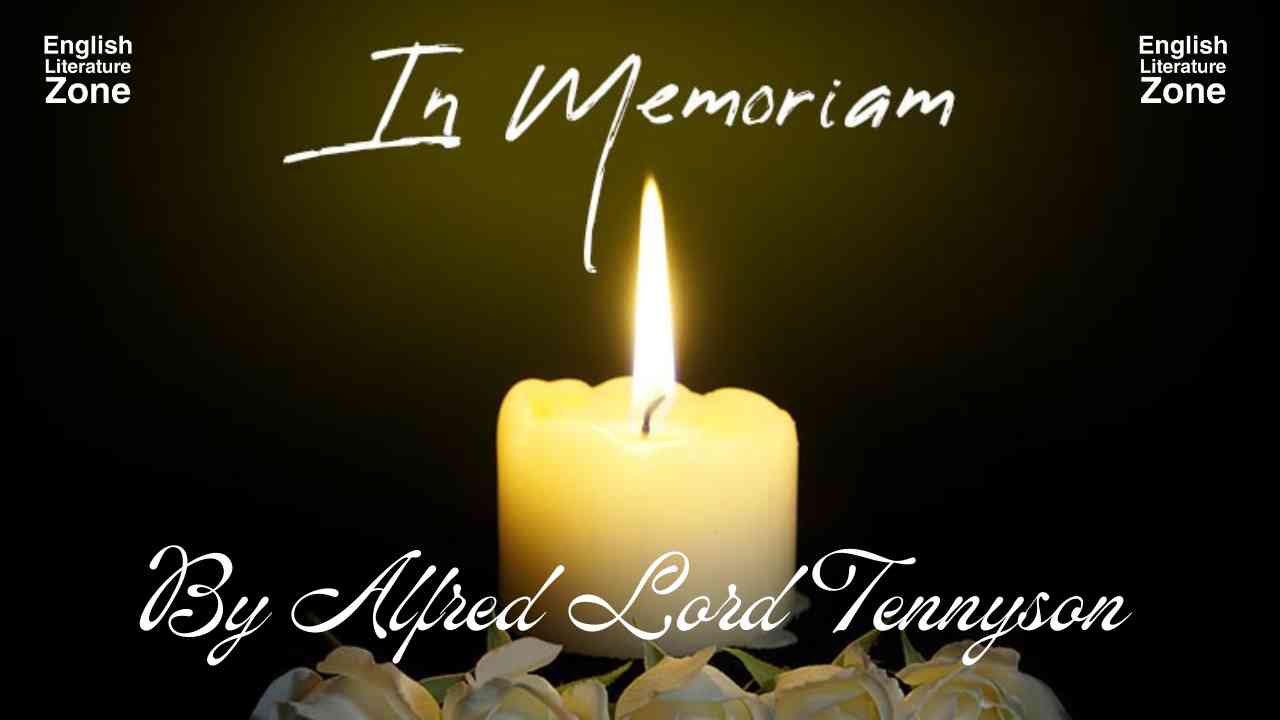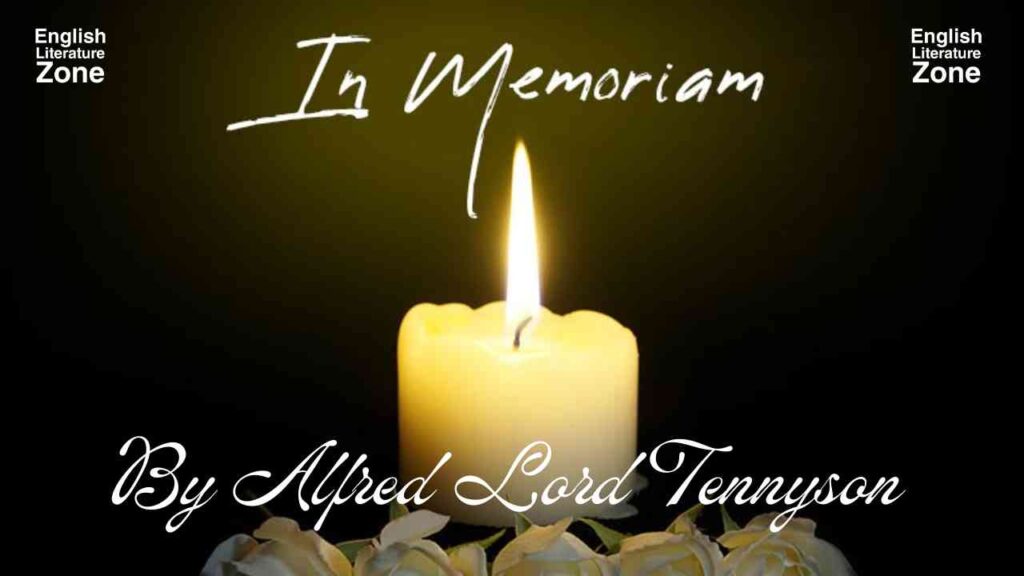In Memoriam by Alfred Tennyson

Introduction
“In Memoriam” by Alfred Tennyson is one of the greatest poems of the Victorian age. This poem is also known as ‘In Memoriam A. H. H. It is an elegy for his Cambridge friend ‘Arthur Henry Hallam’, who died at the age of twenty-two years, in Vienna in 1833. Tennyson wrote this poem in his memory. He first published the poem in his memory.
Tennyson first published the poem anonymously in 1850 and is nearly anonymously in 1850 and is nearly 100 pages long. The poem has 133 cantos, and each stanza contains four lines. The rhyme scheme is ABBA, in iambic tetrameter, a form known as “Memoriam Stanza” due to its melancholy effect. The poem is divided into three main parts:
◽ The Prologue
◽ The Poem
◽ The Epilogue
About Alfred Tennyson
Alfred Tennyson was an English Poet. He was the Poet Laureate during much of Queen Victoria’s reign. His works not only explore the relationship between science and religion, but the importance of perseverance and remaining optimistic in front of despair. Two of his best known poems are – ‘In Memoriam A.H.H.’ and ‘The Charge of the Light Brigade’. Tennyson also held high standing in Victorian society, having the title of ‘1st Baron Tennyson of Aldworth and Freshwater.’
Some of his other most famous works include – ‘The Lady of Shalott’, ‘Ulysses’ and ‘Idylls of a King.’
Themes of “In Memoriam” Poem
In Memoriam A.H.H. is a long and complex poem, and it explores a wide range of themes. Some of the most important themes include:
- The Meaning of Life
- Mystery of Death
- Grief as a form of Love
- Doubt strengthens Religious faith
- Grief and Loss
- Faith and Doubt.
- The relationship between the individual and the universe.
The Meaning of Life
The poem explores the meaning of life. Tennyson asks questions about the purpose of existence, and he searches for answers in nature, in history, and in his own faith.
Mystery of Death
After his friend Hallam’s death at a young age, the speaker asks two significant questions about the mystery of death – Is there life after death for humans? And can the living still love and communicate with the dead?
The speaker believes death ends the life of Hallam’s physical body, but not his soul, personality, or memories.
Grief as a form of Love
The speaker says in Canto 1, that without love, there would be no grief, love is essential to grief. His deep sorrow at Hallam’s death proves his deep love for his friend in life. The Speaker’s grief often takes the form of singing and music both expressions of praise and deep emotion.
Doubt Strengthens Religious Faith
Formally a steadfast, but perhaps somewhat rote, believer in the Christian religion the speaker grapples with uncertainty. He can’t prove his beliefs are true. He has no evidence of an afterlife where Hallam’s soul will live in eternity.
Grief and Loss
The poem is a meditation on the death of Tennyson’s friend Arthur Hallam. Tennyson’s grief is raw and honest and he does not shy away from expressing his sorrow. The poem offers comfort to those who have lost loved ones, and it shows that grief is a normal and healthy response to loss.
Faith and Doubt
The poem also explores the themes of faith and doubt. Tennyson is a devout Christian, but he also struggles with his faith in the face, of Hallam’s death. He questions God’s goodness and justice, and he wonders if there is any meaning in life without Hallam. The poem shows that faith is not always easy, but it can offer comfort and hope in the face of loss.
The Relationship between the Individual and the Universe
The poem explores the relationship between the individual and the universe. Tennyson Contemplates the place of humanity in the cosmos and he wonders how to find meaning in a vast and indifferent universe.
These are just some of the themes explored in ‘In Memoriam A. H. H. The poem is a complex and profound work of art, and it continues to offer insights into the human condition.
Summary Of The Poem
The poem opens addressing Jesus, discussing how God made both life and death. He uses the image of Jesus with his foot on a Skull to show him as the conqueror of Death. Humanity is humbled in the presence of God, as our ‘systems’ are finite. We are unable to see God’s plan.
Tennyson asks for God’s forgiveness for the nature of his words, as he fluctuates between faith and doubt throughout the poem. He says he has “Wild and wandering words’ as he tries to make sense of the death of his friend. He prays for wisdom and regrets his wasted youth. The poet describes how he grieved. He once believed that men would slowly rise from death into eternal state, he once believed in God, but in his grief, he wishes he could fast forward through time to skip the grieving period.
Tennyson addresses a yew tree in a graveyard. He imagines that the roots are wrapped around a body buried beneath. The seasons, and nature, move on in their patterns beating out the “little lives of men”. Here he questions the existence of God and an afterlife. He sometimes believes he is sinning by writing of his grief.
He argues that even though the loss of a loved one is common to the human race, it doesn’t make him less bitter, but more so knowing that every day someone else’s heart is breaking. He imagines families who are still waiting for their dead family members, like a mother who waits for her son who has drowned at sea.
Arthur’s body was returned to England from Italy by ship. He spends a lot of time addressing and describing the ship that brought his friend’s body. By winter, Tennyson’s woe is causing “Wild Unrest” in him. He confronts this change in canto 16, wandering that sorrow could cause him to feel both wild and calm. Only the Bible comforts him.
As he questions the meaning of death and life, he concludes that humans have souls allowing them to live on after death and that their purpose on earth is to gain knowledge. As the author was a good and intelligent man, he believed that Arthur’s soul must be alive somewhere. He imagines meeting with him again.
The epilogue finds Tennyson at his sister’s wedding while he has lost a close friend, he has gained a brother-in-law. Arthur Hallam and Tennyson became friends in 1829 at Cambridge. Hallam met Tennyson’s sister, Emily, and the two were soon engaged. Hallam also wrote poetry and he and Tennyson planned to one day publish a collection together. He died of a brain hemorrhage while visiting Vienna with his father at the age of twenty-two. Emily would later marry and name her first son after Hallam.
Queen Victoria met with Tennyson in 1833 to tell him the poem had been a comfort to her following the death of her husband, Prince Albert.
Conclusion
Thus, “In Memoriam” by Alfred Lord Tennyson was specifically composed as a heartfelt lament for the untimely passing of his dear friend, Arthur Henry Hallam. The poem is undeniably an elegy, intended to evoke a prevailing sense of mourning. However, some critics believe that the elegiac quality of the poem is overshadowed by its religious scientific, and philosophical aspects. It is also a reflection of the intellectual and cultural climate of the Victorian age, which was marked by both scientific advancement and religious crisis.
Are you struggling to keep up with your English Literature Coursework? Do you need detailed, customized English Literature Notes to help you better understand the texts you’re studying? “Look no further! Our customized paid notes will help you achieve your study goals quickly.
- Mechanical Reproduction By Walter Benjamin | The Work of Art in the Age of Mechanical Reproduction

- The Interpretation of Dreams By Sigmund Freud

- Victorian Period | Victorian Literature and Culture

- Dear Life by Alice Munro Summary, Themes, & Analysis

- The Lotos-eaters by Alfred Lord Tennyson

- Studies in the History of the Renaissance

- The Prologue to The Canterbury Tales By Geoffrey Chaucer

- Hayavadana By Girish Karnad | Hayavadana Themes & Analysis

- The Bluest Eye By Toni Morrison | The Bluest Eye Summary

- Top Girls By Caryl Churchill | Top Girls Analysis

Related Tags: In Memoriam by Alfred Lord Tennyson, In Memoriam by Alfred Tennyson, In Memoriam summary, In Memoriam analysis, In Memoriam Alfred Tennyson, In Memoriam Themes, In Memoriam in Literature
















